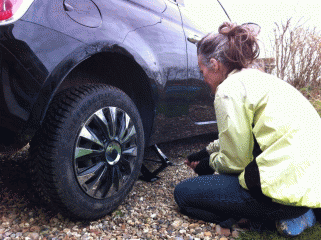Winter Tyres in the UK, worth the hassle?

Actually you can't really know if it's ever worth the hassle. Cost wise the only additional expense is interest lost on the capital outlay (£400 for our rims+tyres). Because the winters wear down no faster than usual summer tyres (actually, if used correctly the winters wear down more slowly than summers would). If you do what we did which is buy the tyres on steel rims, then there's the cost of the steel winter rims themselves, too (but these rims have resale value, and in winter conditions they also wear down more slowly than good quality summer alloy rims).
UK Winter tyres perform better (better traction, less wear) at road surface temperatures of approximately 7 degrees C and below. Road temps tend to be 1-2 degrees C lower than air temperature, but the relationship isn't consistent (the road surface can even be warmer, especially on still, sunny dry days). In the winter of 2013-14 our Fiat 500 had winter rims + tyres from 1 November to 23 February, and we kept track of air temps for about 2/3 of the Fiat's journeys. The total mileage in various air temps was:
Air temp 7 degrees or less: 1014 miles
Air temp 7-9 Degrees: 360 miles
Air temp > 9 degrees C: 53 miles

Those numbers reflect the exceptionally mild conditions of this winter, when not once did the dashboard thermometer show temperatures below freezing. Nonetheless, the air temps suggest that the winter tyres provided superior performance (better traction, less wear and tear) for > 1000 out of 1427 miles, or about 2/3 of the time. However, the very best thing about winter tyres is that 30 years after Julii's driver ed course she finally learned to change a wheel (woohoo!). Messy, physical & time-consuming job, but not impossible and quite satisfying, even for the mechanically declined.
Next question: Did the winter tyres come off too early? Update in April to see what happened!
